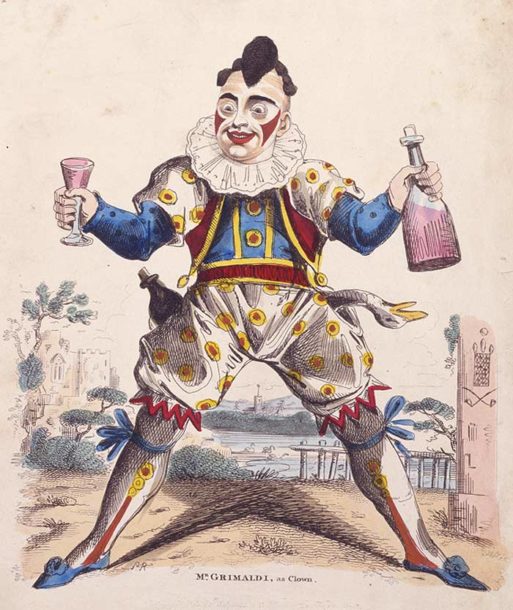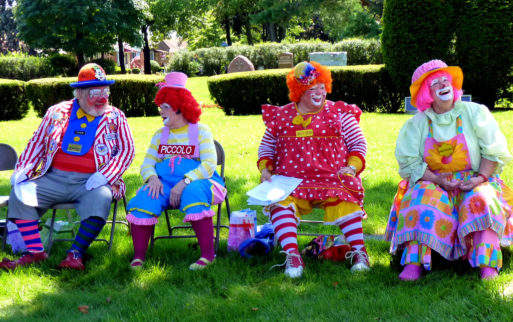As incongruous as it sounds, funeral clowns were once a long-standing tradition in Europe. During the classical period of the Greeks and Romans a funeral clown dressed up as the person who died, wore a mask of his face, and danced about, imitating him. As the funeral procession made way, the well-paid merrymaker would run around the coffin together with other clowns in order to make the grieving relatives laugh. The Romans believed that this would placate the spirits of the dead and bring joy to the living.
 This “archimimus,” or funny man of ancient Rome, might lampoon the mourners as well. First century historian Suetonius, in his “Life of Tiberius,” described how one performer cajoled the crowd at the funeral for the emperor — yes I said emperor — Vespasian. (No rank was too high to avoid this last rite.) Nineteenth century historian Lucius M. Sargent described the clown’s antics: “The fellow openly crack(ed) his jokes on the absurd expense of the funeral.” And the joke did not stop there. The punchline declared how much better it would have been to throw the body in the river and (wink-wink, nudge-nudge) save the country the money, according to Kathy Benjamin, author of “Funerals to Die For.”
This “archimimus,” or funny man of ancient Rome, might lampoon the mourners as well. First century historian Suetonius, in his “Life of Tiberius,” described how one performer cajoled the crowd at the funeral for the emperor — yes I said emperor — Vespasian. (No rank was too high to avoid this last rite.) Nineteenth century historian Lucius M. Sargent described the clown’s antics: “The fellow openly crack(ed) his jokes on the absurd expense of the funeral.” And the joke did not stop there. The punchline declared how much better it would have been to throw the body in the river and (wink-wink, nudge-nudge) save the country the money, according to Kathy Benjamin, author of “Funerals to Die For.”
Ritual Redux
A less edgy funeral clown industry has re-emerged in Europe.
Dutch funeral clown Roelof van Wijngaarden (who prefers to be called a “ritual clown”) aspires to a kinder, gentler poke in the ribs that offers friendship and intense understanding as mourners bid farewell. Long fascinated with how other non-western cultures have incorporated funeral clowns into their death rituals, he strives to create a comfort zone that incorporates how the bereaved deal with their emotions and finding personal ways to honor the dead.
At the funeral of a very vain person, Roelof first polished the lid of the coffin before facing the public, and remarked, “So, now you are nicely laid out, looking all neat and proper.” According to an article by American journalist Connie Moser, mourners are often first bewildered by Roelof, but “Once he gets started, he is even able to generate a warm round of applause for the deceased.”

Credit: Credit: yoperann via flickr.com
Roelof admits his favorite trick is to break wind loudly during a solemn part of the proceedings, which admittedly cracks me up, coming from a performer who also says,”I’m only there for those who want to see me “(sniff-sniff-nudge-nudge). But seriously, as a member of the Network of Funeral Service Renovators (NFSR), Roelof seeks to innovate funeral conventions together with the talents of over 100 other funeral directors, artists, musicians, writers and other creatives, all of whom offer alternative ways to express last goodbyes.
“Funerals are generally sad, but some people want the occasion to be more lighthearted,” says Gerry Perry, aka John Brady from Drimnagh. The idea for his funeral clown service Dead Happy Ireland came to him when he and some friends talked about how they wished to be remembered. First he joked that he’d like to be buried in a clown costume. “Then I thought about the idea of having clowns at funerals,” says the entrepreneur.
According to Marry Brokking, of Brokking and Bokslag Funeral Directors in Haarlem and chairperson of the NFSR, many are enthusiastic about new opportunities for celebrating or mourning the life of loved ones. She adds, “People who have led a colourful or eccentric life often want their send off to reflect their personality.”

 Funeral Clowns Making a Comeback
Funeral Clowns Making a Comeback


 How Dare You Die Now!
How Dare You Die Now!
 Debating Medical Aid in Dying
Debating Medical Aid in Dying
 “Help Me, Helen”
“Help Me, Helen”














